Ride1UP Portola E-Bike Review | A Lot of Bike For Little $$$
A fun and useful folding e-bike packed with features at a price that’s hard to match.
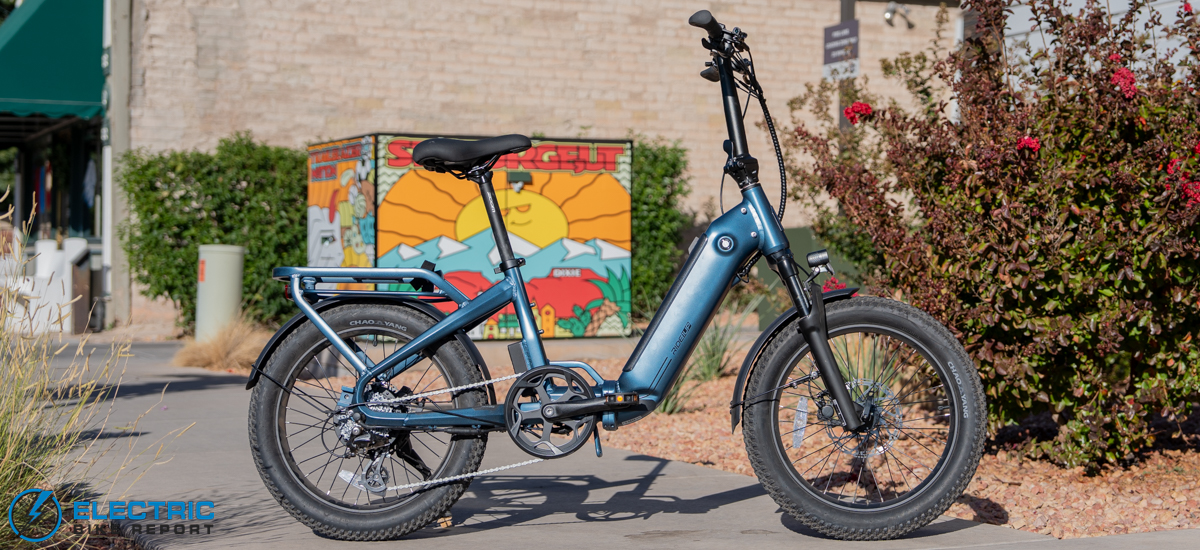
In this Ride1UP Portola review, we’ll explore why this folding e-bike surprised us so much. Simply being inexpensive isn’t enough for a good review. We pass on plenty of cheap e-bikes that lack the quality and performance we expect. The Portola, however, is a rare exception—it delivers far more than you’d expect at this price.
Let’s start with the big picture. The Ride1UP Portola is a folding e-bike equipped with a 750W hub motor, hydraulic disc brakes, an 8-speed Shimano drivetrain, a suspension fork, lights, fenders, an integrated rear rack, and a kickstand. Buyers can choose between a 500Wh or a 643Wh battery, depending on their needs and budget. The battery is neatly integrated into the step-through frame, enhancing the bike’s sleek design.
Folding frames are often a make-or-break feature when choosing an e-bike. You’re either looking for a folding bike or you’re not—and that’s fair. However, the Ride1UP Portola offers such exceptional value that we recommend it to anyone seeking a great deal—not just those who want a folding e-bike. Its combination of features, performance, and affordability makes it a standout in its category.
There’s plenty to unpack with this e-bike, so let’s dive in.
 Pros
Pros- 750W brushless geared hub motor produces 65Nm of torque is more powerful than we typically see on a folding e-bike
- Consumers can choose between batteries with either 500Wh capacity or 643Wh with a very reasonable upcharge for the larger battery
- Comes with an 8-speed Shimano Altus drivetrain, which is quite rare at this price point
- Hydraulic disc brakes are also seldomly-seen at this price, and they work well to boot.
- Comes with a full range of accessories for commuters including rear rack, fenders, front and rear lights and a kickstand
- Because the rear rack is integrated into the frame for greater strength, it has a higher-than-usual weight capacity of 130 lbs (and works with a passenger package or Thule child seats).
- 80mm-travel suspension fork smooths rough roads
- Can be unlocked to go Class 3 speeds.
- Fits a wide range of riders. People 4’10” up to 6’4” can ride the Portola but…
 Cons
Cons- The Leg extension is a bit on the short side. Riders on the taller end will want to lean into motor help to not tire your legs out.
- Battery : 499Wh lithium-ion
- Display: Black and white LCD, mounted at grip
- Motor: 750W brushless, geared hub motor, 65Nm torque
- Controller: 20A
- Headlight: 40 lux
- Taillights: 6V
- Pedal Assist:
- Range: Up to 40 mi., estimated
- Throttle:Thumb button
- App:No
- UL Certification:UL 2271 Certified
- Claimed weight: 59 lbs.
- Rider height range: 4 feet 10 to 6 feet 4
- Maximum rider weight: 300 lbs.
- Maximum load on the rear rack: 125 lbs.
- Total payload capacity: 300 lbs.
- Brakes: Gemma hydraulic disc brakes, 180mm rotors
- Fenders: N/A
- Fork: 80mm-travel suspension fork
- Frame: 6061 hydroformed aluminum
- Drivetrain: 8-speed Shimano Altus, 11-32t cassette
- Grips: Ergonomic rubber
- Saddle: DDK city comfort
- Handlebar: Alloy, 6-degree sweep, 600mm wide
- Kickstand: Included
- Pedals: Sunlite folding, with reflectors
- Tires: 20 x 3-in., with low-profile tread
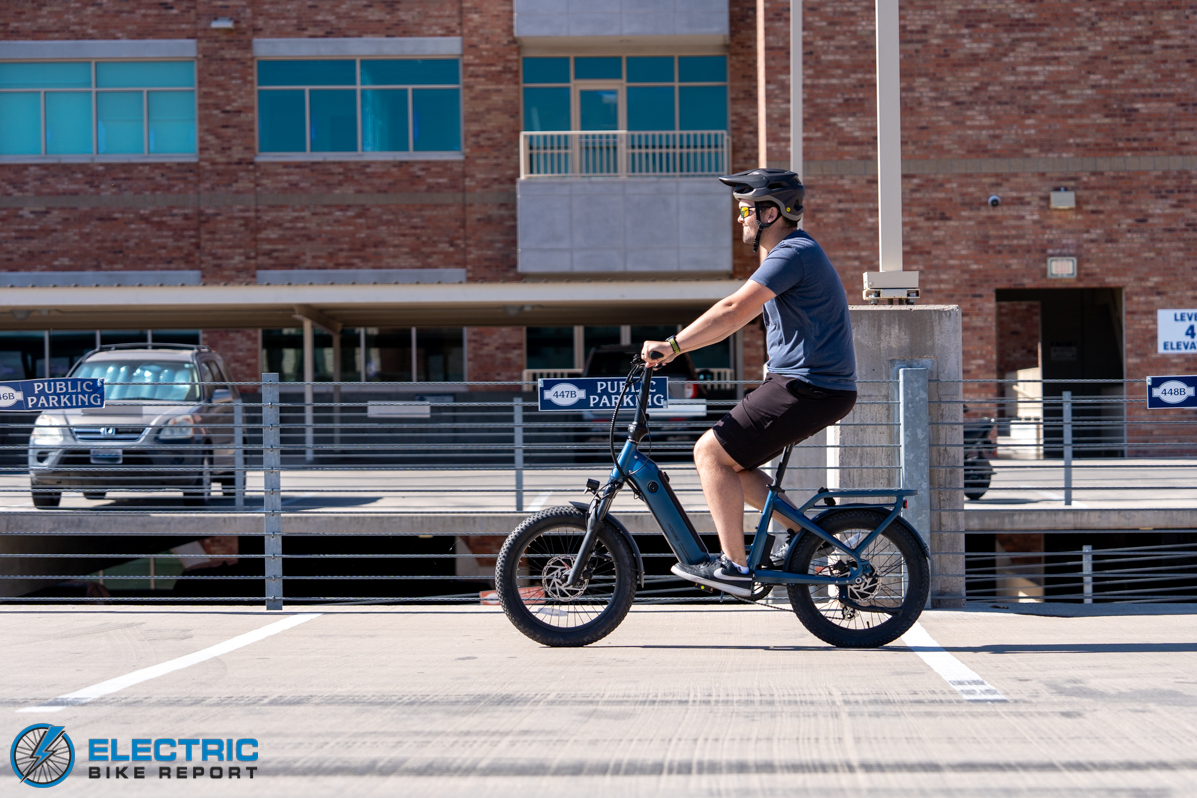
The Ride1UP Portola has a smooth ride. It’s nimble and gret for darting around town!
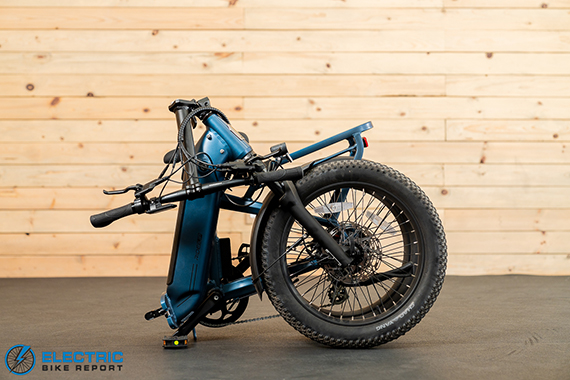
Ready for storage! When folded down, the Portola measures W x H x L – 19” x 29.5” x 33”
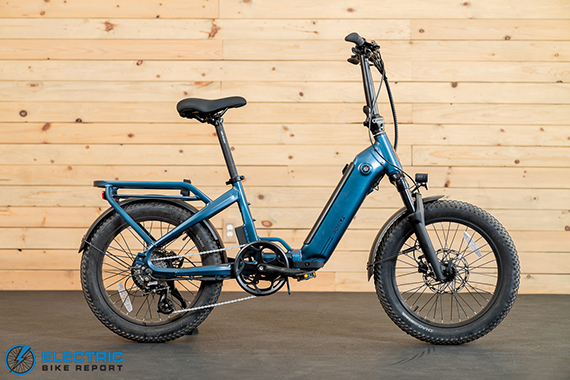
Most electric folding bikes we’ve tested have a 500W or less motor. Ride1UP went big with the 750W motor on the Portola for a ride with plenty of kick.
Ride1UP Portola Review: Speed Test
Before we discuss just how the Ride1UP Portola performed, I want to take a moment to say that, here at Electric Bike Report, we test lots of e-bikes with hub motors and cadence sensors and their power delivery in PAS 1 and 2 usually leaves something to be desired. There’s assistance, but not enough to be satisfying.
Pedaling with the motor off my speed was a leisurely 8.7 mph. When I turned the motor on, PAS 1 gave me a modest boost and my speed increased to 9.9 mph. For reasons we couldn’t determine, I experienced a delay any time I switched from PAS 1 to PAS 2, but once the controller made the switch, my speed climbed 2 mph to 11.9 mph. When I bumped the assistance up to PAS 3 I experienced a rather significant jump in pace, up to 16.2 mph, which made for a more enjoyable ride. PAS 4 saw yet another noticeable jump, up to 18.9 mph, which didn’t leave much room for PAS 5, which saw my speed climb to 20 mph.
The Portola ships as a Class 2 e-bike but can be unlocked to achieve Class 3 speeds, which leaves open the possibility that PAS 5 could be faster.

Thanks to how it fits in almost any trunk, you can unfold the Portola and enjoy a ride wherever you head to.
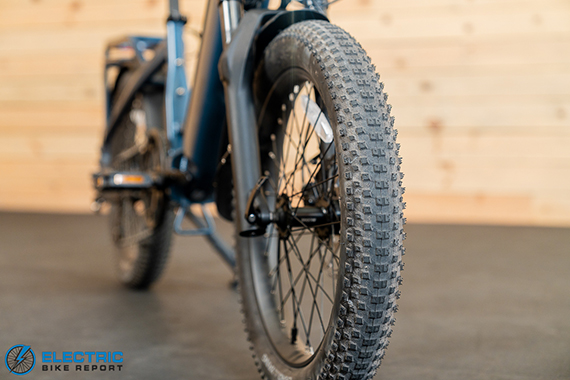
20” x 3” tires with a slight knobby tread. Good for balance and grip in dry or wet conditions.

You can pick your battery size. Either a 500Wh stock battery, or a 643Wh battery for $100 more.
Ride1UP Portola Review: Range Test
When ordering the Ride1UP Portola buyers face a choice. They can go for the most cost-effective version, which comes with a 10.4Ah (499Wh) battery, or for an additional $100 they can roll with a 13.4Ah (643Ah) battery. Because our Portola came to us prior to its release there was a snag in battery availability and we ended up doing our tests with the optional spare 14Ah (672Wh) battery.
Ride1UP estimates that riders will see between 25 and 40 mi. With our 14Ah (672Wh) battery we had almost 30 percent more capacity than the stock unit won’t reflect the range estimates shown on the website, but we can do math to see how our results stack up.
As usual, we did two different range tests, one in PAS 5 and another in PAS 1. In PAS 5, we covered a total of 22.67 mi., while in PAS 1, we rolled for 49.56 mi.
To reiterate, our results reflect riding with the 14Ah battery, not the 10.4Ah battery that comes standard. Based on our math, riders can expect to see something like 15 mi. while riding in PAS 5, while PAS 1 should yield a result in the 32-mi. range. If you spring for the upgraded 13.4Ah battery (which I’d recommend) you should see between 21-47 miles.
These are decidedly modest results, notably below the numbers Ride1UP published on their website. We don’t want to harp on this too much because folding e-bikes come with a need that no other e-bike style faces in the same way; a folding e-bike can’t be too terribly heavy or it can’t be lifted. The two easiest ways to reduce an e-bike’s weight are to spec a smaller battery or a smaller motor.
Ride1UP chose a 750W motor for the Portola so that its absolute performance wouldn’t suffer, so they went with a smaller battery that will require the rider to recharge more often. And for those who don’t mind the extra weight or suffer range anxiety, they can order the 13.4Ah or add the 14Ah range-extending spare battery.
Ride1UP Portola Review: Hill Test
Justin began by climbing Hell Hole on the Portola with just throttle. If an e-bike is going to struggle on climbs, it will show up most readily by riding with just the throttle. Justin managed a respectable 90-second ascent for an average speed of 12.1 mph.
One his second ascent, with his power added, the Portola scooted up Hell Hole in a time of 1:17, shaving off 13 seconds, for an average speed of 14.1 mph.
That an e-bike this affordable managed to ascend Hell Hole on just the throttle is impressive, but that’s in part due to something equally impressive: We don’t see 750W hub motors on e-bikes near the $1000 price point.
Even more impressive is the fact that both these times were a bit quicker than our current average times for both throttle-only and while pedaling. To deliver an above-average performance even as it offers one of the most affordable options on the market is borderline shocking.
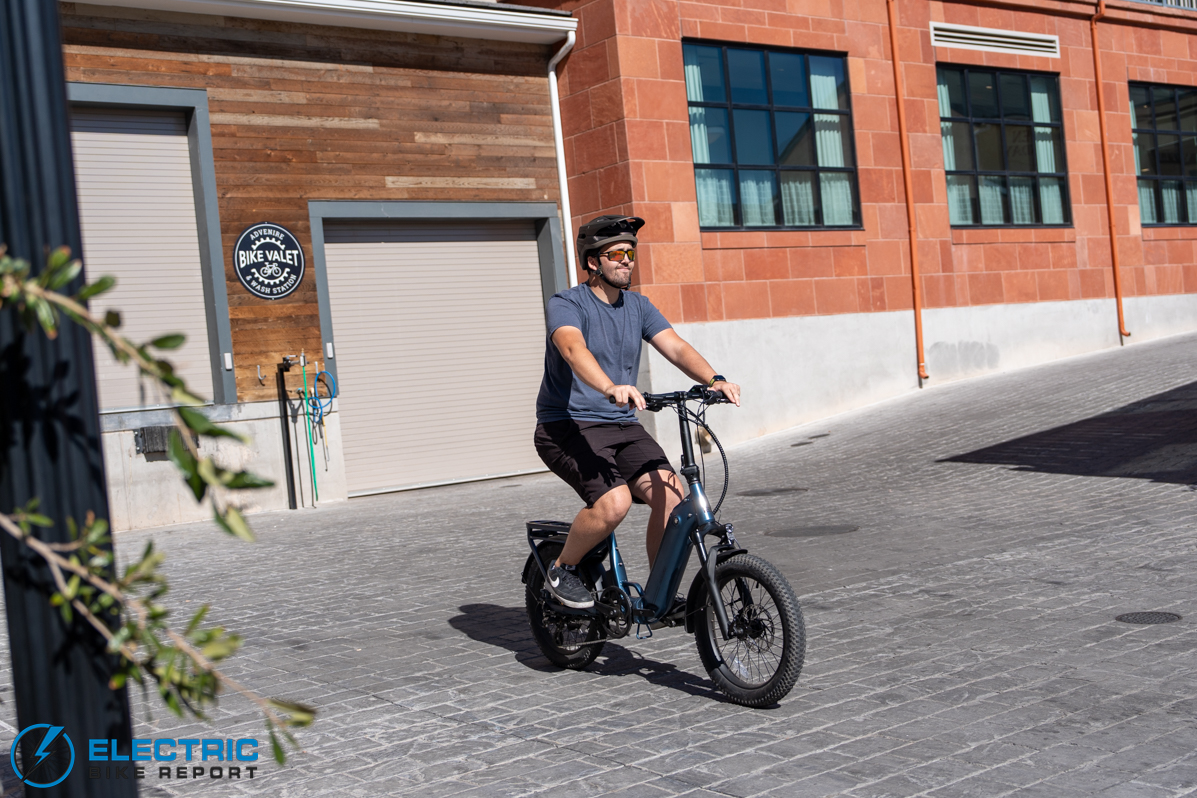
Even as a 6’1” rider I was pretty happy with the fit of the Portola. A little more leg extension would have been nice, but it fit me better than most folding e-bikes.

An 8-speed Shimano Altus groupset was a pleasant surprise given the price of the bike, but we’ll happily take it!
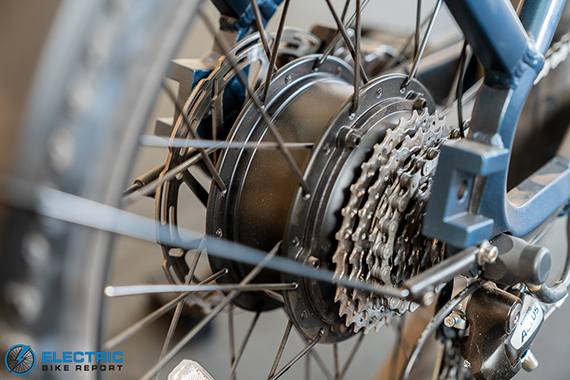
Most electric folding bikes we’ve tested have a 500W or less motor. Ride1UP went big with the 750W motor and it did pretty well on the hills!
Ride1UP Portola Review: Brake Test

We were surprised to see hydraulic disc brakes on the Ride1UP Portola. That’s unheard of on e-bikes in this price range. We weren’t familiar with the Gemma brand, but that’s what our brake test is for.
As is our practice, we took the Ride1UP Portola up to 20 mph and then measured its stopping distance, performing this test three times and then averaging the results.
The Ride1UP Portola recorded an average of 20 feet 8 inches. So how does that compare to other e-bikes? Well, it’s more than a foot better than our current average of 21 feet 9 inches. Gemma may be a name new to us, but these brakes performed better than some brands we’ve been riding for years.
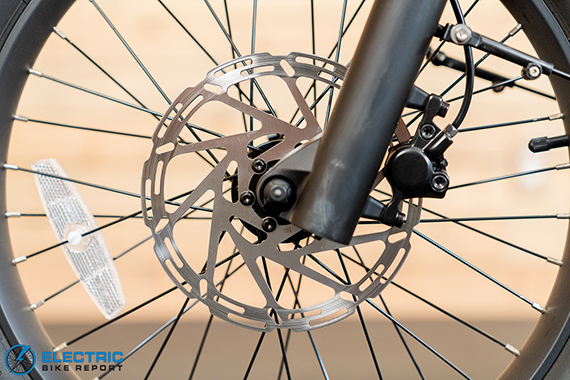
180mm rotors have plenty of stopping power.

It takes careful cable routing to spec hydraulic brakes on a folder, but the Portola was up for tha challenge and it provides good braking with a light squeeze.
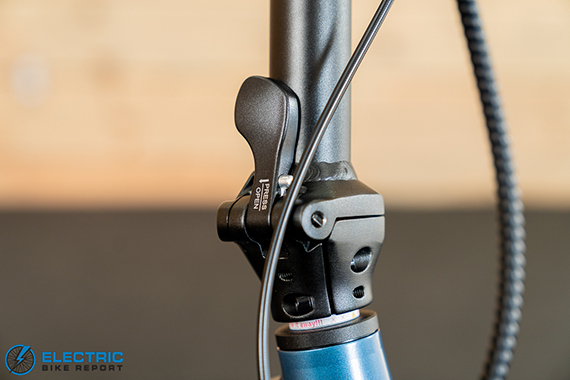
There are two points to release the large folding stem. Many of these stems have a bit of front-to-back wobble, but the two point security seemed to eliminate that.

One of the top comments when we review a folding e-bike like the Portola: “Does it have a lot of frame flex?” Short answer, not really. It’s a pretty solid hinge.
Ride1UP Portola Review: Ride Quality
This is also a handsome e-bike. With its hydroformed tubing and integrated rear rack, it has a good look. And that integrated rear rack is worth its own mention. Most rear racks are bolted on and their weight rating is limited by the bolts that mount the rack to the frame. With a rack that’s welded on, the Ride1UP Portola offers a substantial 130-lb. payload capacity. The e-bike’s total weight capacity is 300 lbs., which is pretty typical of e-bikes in this price range. Should someone want to max out what they are carrying, it’s important to understand that the 130 lbs. counts as part of the 300-lb. total.
The Ride1UP Portola comes in three different good-looking colors, adding an additional measure of choice to a truly affordable e-bike.
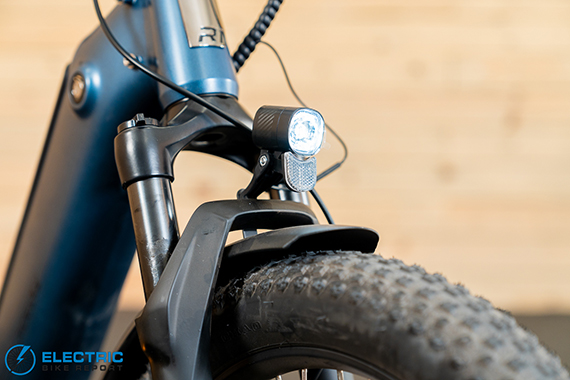
Usually when shopping at these prices there are easy areas to skimp where customers won’t get mad. But Ride1UP didn’t skimp! Lights and fenders come included.
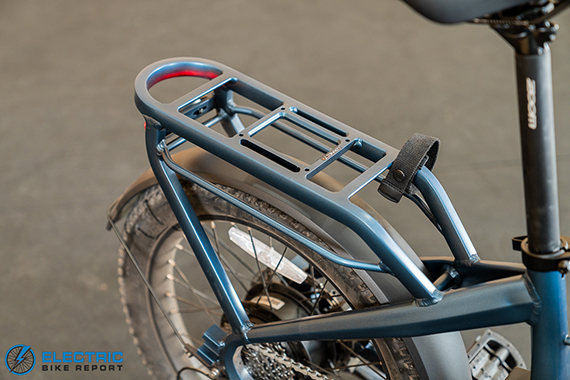
Look, this might sound like a dumb point to make, but I LOVED that they included a simple but effective way to help keep the bike closed when it’s folded. Your non-pinched fingers will thank you.

Overall the seat is pretty comfortable and the telescoping height helps accommodate the wide 4’10” – 6’4” range of riders who can ride the Portola.
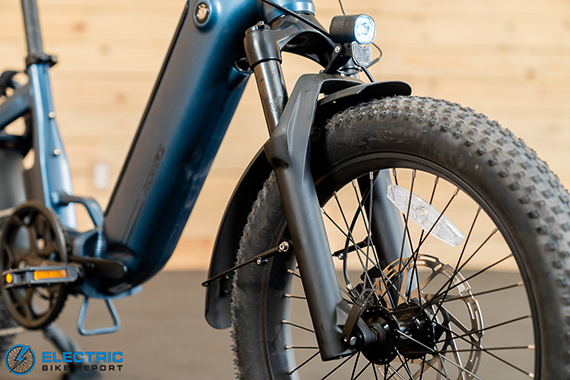
80mm travel on the Trama fork is enough for making a ride smoother than a bumpy road typically gives.
Ride1UP Portola Review: Summary / Where to Buy
Electric Bike Report picked the Ride1UP Portola as one of the best new electric bikes of the year!
We review a lot of e-bikes each year. A few times a year we run across something that impresses us as being out of the ordinary, better than what we might usually expect. Every now and then an e-bike shocks us due to its extraordinary value to price ratio. The Ride1UP Portola offers what is arguably the biggest surprise we’ve seen in a couple of years.
It is also very obvious that the Ride1Up is a shot across the bow vs the uber-popular Lectric XP 3.0. Ride1Up even priced this model $5 below the XP 3.0.
Normally, when we see a new e-bike push the bounds of value, we will see one or two—three at most—upgrades over similar competitors. The Portola is as full of surprises as a haunted house. It’s worth going back over the many details of this e-bike we didn’t expect.
First, the Portola is unusual among the folding e-bikes we’ve tested and those in the sub-$1500-range thanks to its 750W, 65Nm, brushless, geared hub motor. Second, hydraulic disc brakes in this price range are unusual, nearly unheard-of; mechanical disc brakes are the go-to on e-bikes that cost less than $1500. Third is an 8-speed Shimano Altus drivetrain equipped with an 11-32t cassette. The drivetrain sports a trigger shifter that we find much easier to use than the thumb shifter common to 7-speed drivetrains, but the benefits don’t end there. We run across plenty of e-bikes that claim can be unlocked for Class 3 (28 mph max pedal assist) speeds, but when equipped with a 7-speed drivetrain that is usually paired with a 14-28t cassette, few riders can pedal fast enough to go better than 20 mph; they simply don’t have a gear big enough to go that fast. Rather than a 200 percent gear range, the Ride1UP Portola sports a nearly 300 percent gear range, which will give riders more help on the hills and more meat for reaching top speed.
Generally, e-bikes with hub motors are equipped with a cadence sensor; we’re seeing an increasing number of e-bikes with hub motors that include a torque sensor, but that’s still something reserved for higher price points. But Ride1UP still found a way to give the Portola something better than average. Most cadence sensors include 12 magnets and a rider needs to pedal somewhere between ½ and ¾ of a pedal stroke before the motor springs into action. The Portola sports a 24-magnet cadence sensor which means that the lag between when a rider begins pedaling and when the motor kicks in is cut in half. Same for how quickly the motor stops after a rider stops pedaling.
An e-bike’s weight is influenced by a number of factors. Motor size and battery size are a notable component in an e-bike’s overall weight, but because together they generally weigh less than 20 lbs., the motor and battery rarely constitute more than 25 percent of an e-bike’s overall weight. The other big influencer on weight, then, is how expensive the e-bike is. The better the components, the less they weigh. The Ride1UP Portola weighs just 59 lbs. (with the 500Wh battery), making it easier to pick up than many competing folding e-bikes. In yet another pleasant surprise, considering its price, we would expect more weight, not less.
Part of the task of any review is to identify a product’s weaknesses. What could be better? Criticizing the Ride1UP Portola runs the risk of making the reviewer look like a prima donna. This is an exceptional e-bike for its price. Identifying anything as worthy of improvement ignores just what they’ve achieved. That said, the Portola, thanks to its step-thru frame, has a standover height of 18.2 in.—not bad, but there are e-bikes with lower standover heights. We like seeing e-bikes that come in multiple frame sizes, but currently no one offers folding frames in multiple sizes. More colors? They offer three good colors as it is. A smartphone app that allows the rider to track their riding and adjust the motor’s performance would be terrific. A more reasonable request would be that they spec a larger display that mounts near the stem to make it easier to view while moving.
Not everyone has the space constraints that call for a folding e-bike. The Ride1UP Portola is so well designed that it’s an e-bike we would recommend to anyone looking for a value, not just those looking for a folding e-bike. The Portola confronts any shopper with that most basic of questions: Why spend more if you don’t need to?
Happy Riding! Make sure to let us know if you have any questions down in our comments section or if you think we left anything out in this review of the Ride1UP Portola.




How important is it for the battery to be cl certified in brands such as the Portelo and the sixthreezero? Is that a deal breaker?
I know that the Portola is capable of being set up as a class three e-bike. What speed were you able to achieve in level 5 assist? Did the bike still feel stable at the highest speed as a level 3 bike?
Thanks
It went over 29 mph with a roughly 200 lb rider, and felt plenty stable.